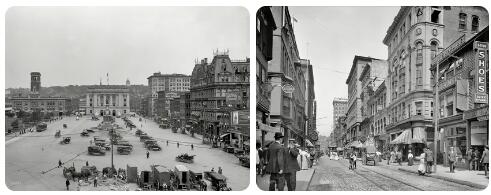Introduction
Rhode Island (abbr.: RI or RI), state of the United States of America, one of the New England states, on the Atlantic Ocean (Block Island Sound and Rhode Island Sound), 3140 km2, with 1 million inhabitants; capital city: Providence.
Physical Geography
The state is located on either side of Narragansett Bay (which includes the island of Rhode Island). The mainland portion of the state is part of the Piedmont, the eastern plateau rim of the Appalachians. To the west, Durfee Hill (242 m) and Jerimoth Hill (244 m) are the highest points of the river-cut plateau. Broad sand strips have been deposited along the rocky coast and lagoons have formed. The rivers have no meaning for shipping, but they are important for the generation of energy; the main dam, the Kent Dam, forces the large Scituate Reservoir into the Pawtuxet River. The location by the sea has a moderating influence on the climate, which, however, is hot in summer and cold in winter due to the westerly wind, which supplies continental air. The average temperature in Providence in January is –7 °C and in July 25 °C, on Block Island 0 °C, resp. 21°C. The annual precipitation is on average 1300 mm and in winter it usually falls in the form of snow.
Population
Rhode Island is the smallest US state, apart from the District of Columbia, but has a high population density (251 inhabitants per km2). About 86% of the population lives in urban areas. The largest cities are Providence, Warwick, Cranston and Pawtucket.
Economy
Manufacturing finished products, especially textiles, has been the backbone of Rhode Island’s economy since the American Civil War. The main industries are metallurgical, machine and textile manufacturing and manufacturing of electrical appliances, precision instruments and jewelery and silverware; Providence is home to the largest silverware factory in the world. Approx. 10% of the total surface area is used as arable land (growing grains and vegetables) or grassland (poultry and dairy cattle); in addition, tree nurseries and fruit growing. Furthermore, fishing and some mining. The greatest economic growth since the 1970s has taken place in the tertiary sector (government, banks, insurance, transport). Main trade center is Providence (port, airport).
Sights
Most tourists come to Rhode Island for the beautiful beaches along the coast and on Block Island. Newport is known for its beautiful 19th-century country houses, the Jazz Festival and yacht races.
History
The name Rhode Island may have come from the Italian Giovanni da Verrazano, who in 1524 named the present Block Island, which he believed to be the size of Rhodes in the Mediterranean Sea, Rhodes.
In 1636 the first group of settlers arrived: individualists and sectarians from Massachusetts. Their leader was Roger Williams, who founded Providence. A second group founded Portsmouth in 1638 and Newport followed in 1639, Warwick in 1643. These four branches united in 1647 under a charter obtained by Roger Williams in 1644. This was renewed in 1663. The colony acquired a very individual character, because complete freedom of religion was introduced. It thus became a refuge for Baptists and Quakers in particular. The revival came in the 18th century, mainly through trade and agriculture. Rhode Island played an important role in the Revolution and already on May 4, 1776, the inhabitants declared their independence from England. The spirit of individualism was so strong that in 1787 people would not resign themselves to the new Constitution; it was not accepted until three years later, and Rhode Island became the last of the original thirteen colonies to join the Union. A small oligarchy of merchants controlled politics and held back all democratization in the 19th century, against which Thomas Dorr rebelled in 1840–1842. His attack on the capital failed, but his demands to expand the right to vote were granted by the state government.
